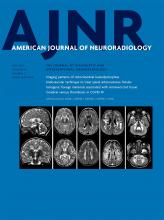Approximately 18%–25% of strokes are caused by atherosclerotic carotid disease.1 For the past 20 years, we have witnessed substantial technological progress resulting in a paradigm shift for carotid artery imaging.1 Using carotid sonography with Doppler to assess the degree of arterial stenosis is still the primary technique used in everyday clinical practice because of the low cost and the low risk-to-benefit ratio. However, different imaging modalities exploring carotid plaque in-depth have identified a few features that may be connected to the high risk of plaque rupture and consequential ischemic events.1
Currently, MR imaging is the technique of choice for direct plaque imaging.2 The best-known vulnerable plaque characteristic is the presence of intraplaque hemorrhage (IPH). The individual patient data meta-analysis of 696 patients with carotid stenosis (560 symptomatic and 136 asymptomatic) concluded that IPH is an independent predictor of ipsilateral stroke (hazard ratio = 11.0; 95% CI, 4.8–25.1), which is more robust than any known clinical risk factor.3 Currently, it is clinically feasible to add the MPRAGE sequence for visualizing carotid plaque in detail to the standard vessel/neck imaging protocol, as it adds only 4–6 minutes to the scan time and requires neither nonstandard coils nor additional contrast agent.2
The natural history of asymptomatic carotid atherosclerotic disease is not yet fully understood; thus, it can be a problem to stratify the prognosis and guide treatment (optimized medical therapy, carotid endarterectomy, or carotid stent placement). A recent meta-analysis, including more than 20,000 participants from 64 studies, showed that the vulnerable plaque detected by MR imaging increased the risk of an ipsilateral stroke (OR =3.0; 95% CI, 2.1–4.3) during a median observation period of 3 years.4 The OR was similar (3.2; 95% CI, 1.7–5.9) among patients with severe stenosis. It suggests that the plaque characteristics visualized by advanced imaging may play a more important role than the degree of stenosis severity.4,5
In this issue of the American Journal of Neuroradiology, Larson et al6 describe a cohort of 449 patients with or without ischemic events who underwent risk stratification with both the assessment of carotid stenosis degree and the presence of IPH. First, they found that the IPH is independently associated with carotid stenosis—the narrower the vessel, the more unstable the plaque. Second, they have observed among a group with mild stenosis (< 30%) that IPH was more frequently present in the symptomatic than the asymptomatic group. This led to the hypothesis based on the available data that the presence of IPH is particularly relevant for ischemic events risk prediction among patients with mild stenosis.
It is important to recognize the existing research and implement it into current guidelines. For example, the European Society of Cardiology recommended in their 2017 Guidelines to consider revascularization of the carotid artery for patients without prior symptoms, with moderate-to-severe stenosis (60%–99%), with a life expectancy of more than 5 years, and the presence of vulnerable plaque characteristics on advanced imaging (IPH or lipid-rich necrotic core).7 It reinforces the message that plaque composition should be considered in clinical decision-making. With their latest revision in February 2021, the US Preventive Services Task Force advised against asymptomatic carotid artery screening in the general population because of possible harm.8 Although we would support their call for rigorous up-to-date trials with long-term follow-up, we would argue that screening itself is not harmful, and rather than directly guiding a patient toward the invasive procedure, it should lead to the multidisciplinary team discussion.9 Moreover, a lack of carotid artery disease recognition in the first place leads to a lack of any treatment, including optimized medical therapy.
The question is not if we should screen for asymptomatic carotid stenosis, but rather how to establish the most effective multimodal screening protocol. There is an urgent need for collective work and randomized clinical trials selecting patients for different treatment modalities so that we can understand their efficacy and safety based on carotid plaque MR imaging or other extended imaging. The work by Larson et al6 further supports the use of MR plaque imaging in this endeavor. For now, we need to embrace available evidence with its inherent limitations and treat our patients the best we can with an individual approach.5
References
- © 2021 by American Journal of Neuroradiology












